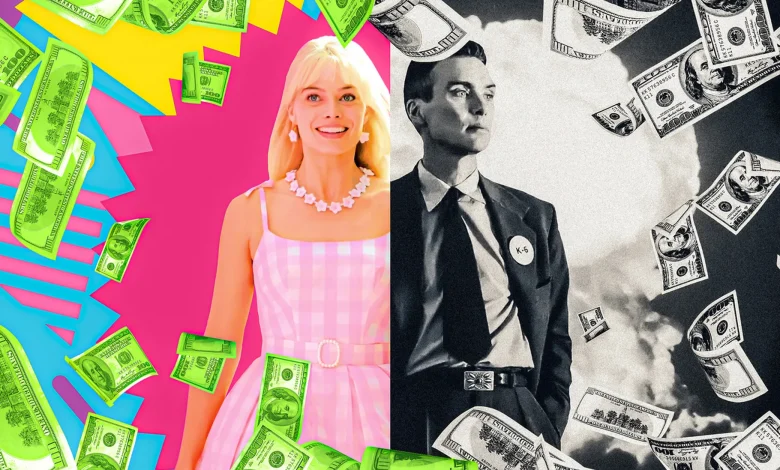A Film Renaissance: The Importance of ‘Barbenheimer’

Molly Kurpis `25 / Emertainment Monthly Co-President
July 21st, 2023. The world has been adorned with shades of bright pink and dark orange. Posters of Cillian Murphy and Margot Robbie are painted on billboards, subway ads and magazine covers. Movie theaters have lines wrapping around the block. Audiences wearing outfits of pink and black flood the streets. Instagram feeds and Twitter conversations are bombarded by a new word, a cultural phenomenon which will define the summer of 2023: ‘Barbenheimer,’ a fateful Friday in July when two of the biggest blockbusters of the year were destined to release on the same day. Despite being drastically different in tone, shooting, and story in general, Greta Gerwig’s Barbie and Christopher Nolan’s Oppenheimer are two movies that have begun to heal the industry’s disparity in dealing with original, authentic cinema. The post-pandemic world watched the film market become amplified by the presence of franchised, recycled ideas.
Sequels and prequels are a relatively strong guarantee for some sort of box office success, promised by a built-in audience and anticipation. Yet cinema has seemingly become dependent on these massive corporations, forgetting what made movies an art form in the first place. ‘Barbenheimer’ was a breath of fresh air, a promise of new and original content not only returning to theaters, but thriving in the box office as well. A return to non-franchised cinema, accomplished through the excitement of audiences and creative marketing tactics, will inspire many future filmmakers to step beyond the safety boundaries of franchised cinema and put their original work on the big screen.

The phrase ‘Barbenheimer’ was not a product of Warner Bros or Universal, two of Hollywood’s largest film production companies behind Barbie and Oppenheimer. Barbenheimer’s roots began on social media, the anticipation of a quintessential double feature brewing from the audience members themselves. Excitement was first propounded by irony; two completely different films created by two completely different directors happened to release in theaters on the same exact day. Audiences found humor in a movie about an atomic bomb playing next to a movie about toy dolls. Yet as the summer continued on, people continued to talk about the double feature, creating black and pink outfits, preparing preposterous schedules to be able to handle such drastically different stories in the same day. Shirts divided in pink and black, shirts dividing Margot Robbie’s face with Cillian Murphy’s, and even shirts with Oppenheimer’s “Now I am become death” in the Barbie font circulated around the Internet. The absurdity of two polar opposite movies releasing on the same day turned from a joke to an event as people started to adorn themselves with ‘Barbenheimer’ outfits, making videos and songs and embracing the fact that new and authentic cinema was finally coming back to theaters. The ticket lineup was no longer saturated with back to back comic book films or the twentieth sequel to a franchise that should’ve ended after the second movie. More than something audiences were familiar with, ‘Barbenheimer’ became a realization that franchised films were not the definitive future of cinema. Furthermore, the cultural excitement surrounding July 21st was done by the audience members themselves, suggesting that the general movie audience’s interests are not only in preexisting media.

Perhaps another reason why ‘Barbenheimer’ was able to garner so much attention was because of the creative marketing tactics used by both movies. Most of the general marketing was set forth by Barbie’s marketing team, which did a phenomenal job at infiltrating shades of pink on billboards and shoes, fashion lines and makeup companies, and even insurance and car companies. Barbie’s marketing was forefronted by Mattel, the toy company behind the Barbie doll itself, which financed the film’s campaign to be as widespread as it could. Barbie’s name could be found on every shelf, in every store or mentioned in some slogan on the wall. Barbie had her own clothing line, ice cream, alcoholic beverages, toothbrushes and handbags. She is a color, a logo, a toy, and now a movie. The Barbie name started to reach an audience beyond young children who might play with Barbie and Ken dolls; instead reaching to generations of adolescents and adults all learning to embrace the new and changing world. Furthermore, Barbie’s merchandise was fun: the bright shades of pink added a cheerful hue to the summer, working to contrast the orange and black that rose from Oppenheimer’s marketing team. Not nearly as widespread, Oppenheimer resorted to the more traditional way of advertising a film, through modes such as posters, billboards, and TV adverts. Yet the internet’s speculation surrounding ‘Barbenheimer’ allowed Oppenheimer to play off of Barbie’s marketing strategies, with posters and merchandise promoting both films. Having such popular commodities surrounding the films caught the attention from audiences beyond Gerwig and Nolan fans, adding to the financial success from both movies as a whole.

While ‘Barbenheimer’ is a wonderful example of what audiences are currently looking for in the film market, one of its charms was the fact that the event was organic and coincidental. It was embraced and celebrated by audiences for fun, not by film companies for profit. However, since the art of cinema is rooted in box office growth, production companies are now seeming to push the release dates of two different films to land on the same day, trying to spark the fire that ‘Barbenheimer’ raged throughout the summer. There have been attempts for a ‘Saw Patrol,’ featuring the new Paw Patrol film and the next horror film in the Saw franchise both releasing on September 29th. ‘Exorswift’ (the Taylor Swift Era’s Tour and The Exorcist: Believer) was also coming to theaters on October 13th, but due to some backlash from movie-fans on the internet, Believer was moved to October 6th. Some audiences were disappointed that the ‘Barbenheimer’ phase was gone, but others were relieved that the spectacle could remain a spectacle instead of a marketing strategy. Furthermore, most of these double features include one or both movies based on an existing film franchise, such as the Saw and Exorcist series. This detracts from the magic that ‘Barbenheimer’ brought to theaters; the mass appreciation of new ideas, of standalone films that are telling stories because there is a story worth being told.
What companies should take away from ‘Barbenheimer’ isn’t the event of a double feature, but instead the notion that many audiences have become bored by franchised cinema and are looking for more original content. Granted, there are still films coming out throughout 2023 that speak to these qualities, such as Emma Seligman’s Bottoms and Emerald Fennell’s Saltburn, but the legacy of ‘Barbenheimer’ was born out of a coincidence and irony, evolving into a cultural phenomenon that came to define the summer of 2023, and movies in the years to come.